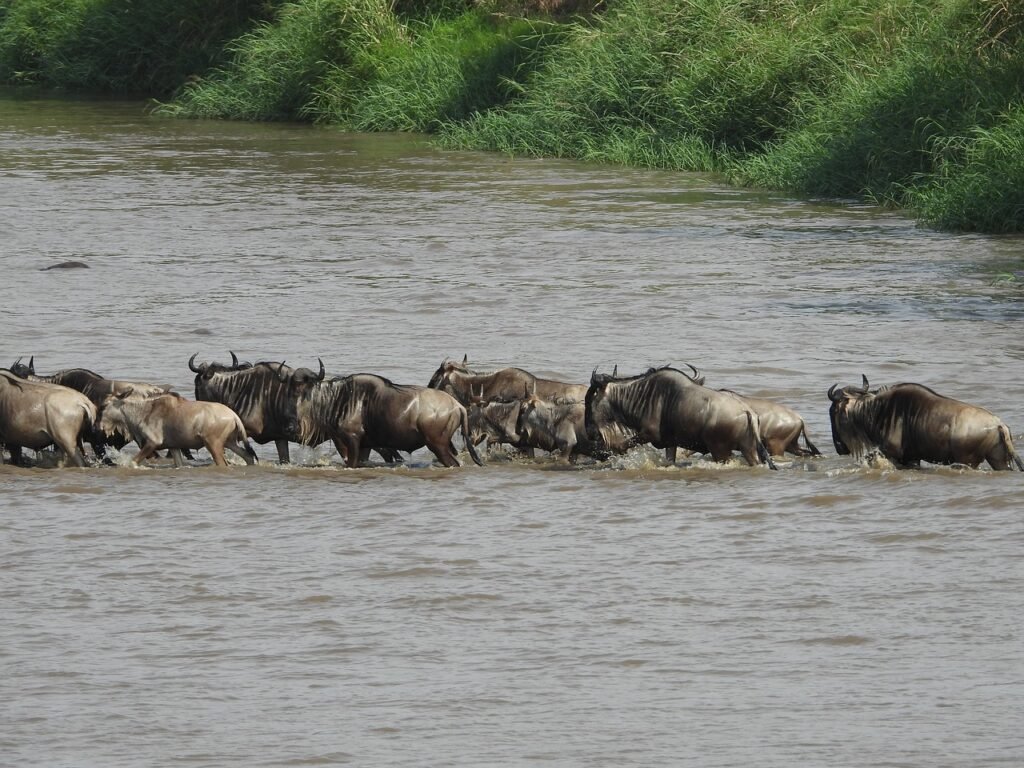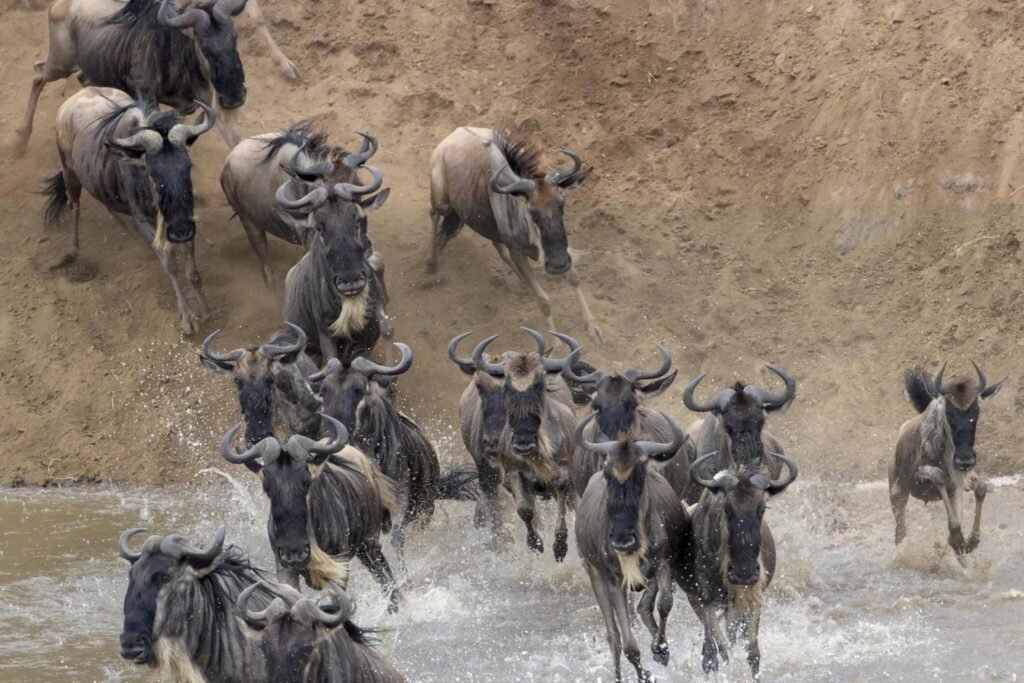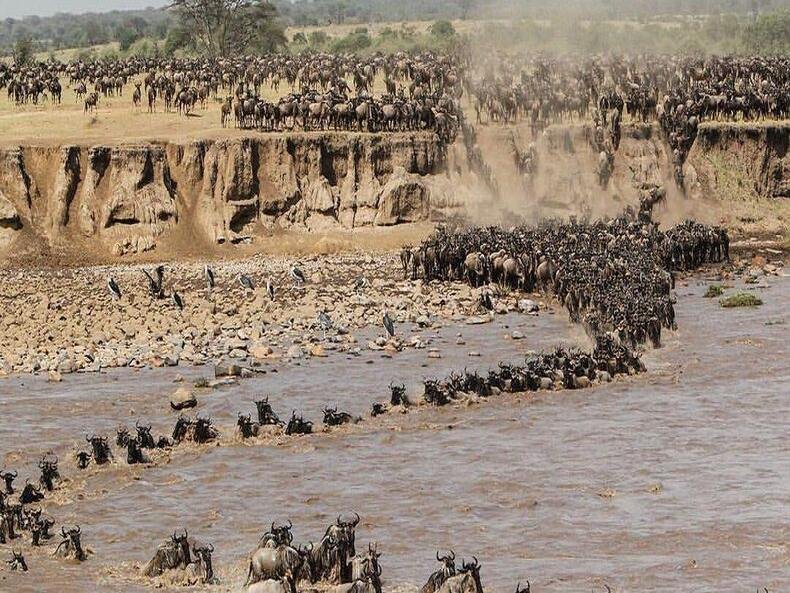Serengeti Wildebeest Migration – 2025 Travel Guide is a spectacular natural event that takes place every year across Tanzania’s Serengeti and Kenya’s Maasai Mara. Millions of wildebeests, along with zebras and gazelles, travel in search of fresh grazing areas and water. This incredible movement creates awe-inspiring scenes of wildlife on the move, as they face predators such as lions and crocodiles. While the sheer magnitude of the migration is widely known, there are numerous lesser-known details that make it even more captivating.
Serengeti Wildebeest Migration – 2025 Travel Guide Planning to witness the wildebeest migration in 2025 or 2026? Visit Kilimanjaro Climb Specialist to learn more and discover safari packages with Eddy Tours and Safaris.

Serengeti Wildebeest Migration – 2025 Travel Guide /What Makes the Wildebeest Migration Unique?
The Great Migration Moves Clockwise
One surprising aspect of the wildebeest migration is its circular route. Each year, about 1.5 million wildebeests travel in a clockwise direction across the Serengeti and Maasai Mara ecosystems, following the rain patterns. The journey begins in the Serengeti, where the calving season occurs in the southern plains, and continues through the western corridor towards the Mara River, before eventually returning south.
- For more details about the migration route, visit WWF Serengeti.

Serengeti Wildebeest Migration – 2025 Travel Guide / A Survival Strategy
The migration isn’t just about moving from one place to another; it’s a survival strategy. The herds must keep moving to find fresh grass and water, ensuring the survival of the species. Along the way, predators like lions, cheetahs, and crocodiles pose a constant threat, but the sheer numbers of the herds ensure that enough individuals survive each year.
- Learn more about predator-prey dynamics during the migration at National Geographic’s Guide.
The Best Time to See the Wildebeest Migration
Understanding the timing of the migration is crucial for planning your safari. Here’s when to visit for the best chance of witnessing specific events:
1. January to March – Calving Season
During this period, the herds gather in the southern Serengeti plains, where over 500,000 calves are born within a few weeks. This attracts predators like lions and cheetahs, leading to intense predator-prey interactions. It’s a great time for those interested in witnessing the cycle of life.
- For information on the calving season, visit Tanzania National Parks.
2. June to July – Grumeti River Crossings
By June, the herds have moved northwest, reaching the Grumeti River. Here, they face the challenge of crossing waters filled with large Nile crocodiles. This dramatic event is a highlight for many visitors.
- Read about river crossings at African Wildlife Foundation.
3. July to September – Mara River Crossings
The migration reaches the Mara River between July and September, creating one of the most iconic wildlife spectacles. The river crossings are dangerous, with many wildebeests falling prey to waiting crocodiles and the strong currents.
- For tips on witnessing the Mara River crossings, check Maasai Mara Guide.
4. October to December – Returning to Serengeti
After spending time in the Maasai Mara, the herds begin their journey back to the Serengeti. The migration moves southwards, returning to the Serengeti plains as the cycle begins again.
Interesting Facts About the Wildebeest Migration
The wildebeest migration is more than just a seasonal movement. Here are some lesser-known facts that make this phenomenon truly unique:
The Role of the Zebras and Gazelles
Many people assume that the migration is solely about wildebeests, but they are not alone. Around 200,000 zebras and 300,000 gazelles accompany them on this journey. Zebras often eat the tougher grass that wildebeests leave behind, creating a mutually beneficial relationship between the species.
- Discover the importance of grazing patterns at Serengeti Research Institute.
Wildebeests Can Smell Rain
Wildebeests have a remarkable ability to sense rain from as far as 50 kilometers away. This ability helps them locate fresh grazing grounds and water sources. The migration largely follows the patterns of rainfall across the Serengeti and Maasai Mara.
- For more insights into how animals sense weather, visit Scientific American.
High Calf Mortality Rate
While over 500,000 calves are born each year during the calving season, many do not survive the first few weeks due to predation or harsh conditions. However, the large number of births ensures that the wildebeest population remains stable despite these losses.
- Learn about survival strategies of calves at Smithsonian Magazine.
Serengeti Wildebeest Migration – 2025 Travel Guide / Planning Your Wildebeest Migration Safari
Choosing the Right Time to Visit
Selecting the right time to witness the wildebeest migration depends on which part of the event you want to see. The calving season offers a chance to see newborns and predator action, while the river crossings provide thrilling drama. Consult with tour operators and use resources like Africa Travel Resource to plan your trip.
Booking a Guided Safari
While it’s possible to self-drive in certain parts of the Serengeti and Maasai Mara, a guided safari ensures you have a knowledgeable guide who can take you to the best locations for viewing the migration. For personalized safari experiences, consider contacting Eddy Tours and Safaris.
What to Pack for a Migration Safari
Packing properly is essential for a comfortable safari. Make sure to bring light clothing for the day, warm layers for early mornings, insect repellent, and a good pair of binoculars for wildlife viewing.
- For a complete packing guide, visit REI’s Safari Checklist.
Serengeti Wildebeest Migration – 2025 Travel Guide: FAQs
1. How many wildebeests take part in the migration?
Over 1.5 million wildebeests, along with 200,000 zebras and 300,000 gazelles, participate in the migration each year.
2. When is the best time to see the river crossings?
The best time to witness the dramatic river crossings is between July and September when the herds cross the Mara River.
3. How far do the wildebeests travel during the migration?
The wildebeests cover about 1,800 miles (3,000 km) during their annual migration, following the rains and searching for fresh grazing areas.
4. Are there any risks involved in visiting during the migration?
Visiting during the migration is safe as long as you follow the guidance of your tour operator and park rangers. It’s important to maintain a safe distance from wildlife.
5. Can I see the migration from both Tanzania and Kenya?
Yes, the migration moves between the Serengeti in Tanzania and the Maasai Mara in Kenya. You can plan your safari in either location depending on the time of year.
Serengeti Wildebeest Migration – 2025 Travel Guide., Ready to witness the wildebeest migration in 2025 or 2026? Plan your safari with experts at Kilimanjaro Climb Specialist or explore customized options with Eddy Tours and Safaris.

